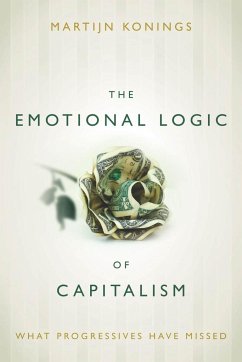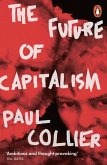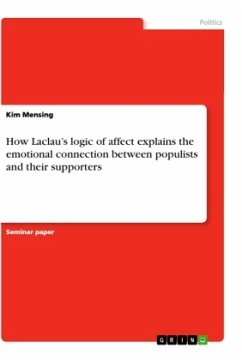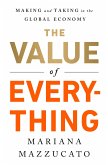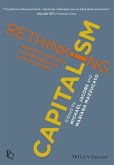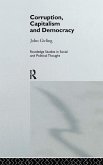- Gebundenes Buch
- Merkliste
- Auf die Merkliste
- Bewerten Bewerten
- Teilen
- Produkt teilen
- Produkterinnerung
- Produkterinnerung
Martin Konings is Senior Lecturer and Australian Research Council DECRA Fellow in the Department of Political Economy at the University of Sydney.
Andere Kunden interessierten sich auch für
![The Future of Capitalism The Future of Capitalism]() Paul CollierThe Future of Capitalism9,99 €
Paul CollierThe Future of Capitalism9,99 €![How Laclau's logic of affect explains the emotional connection between populists and their supporters How Laclau's logic of affect explains the emotional connection between populists and their supporters]() Kim MensingHow Laclau's logic of affect explains the emotional connection between populists and their supporters17,95 €
Kim MensingHow Laclau's logic of affect explains the emotional connection between populists and their supporters17,95 €![The Value of Everything The Value of Everything]() Mariana MazzucatoThe Value of Everything21,99 €
Mariana MazzucatoThe Value of Everything21,99 €![Rethinking Capitalism Rethinking Capitalism]() Rethinking Capitalism26,99 €
Rethinking Capitalism26,99 €![Corruption, Capitalism and Democracy Corruption, Capitalism and Democracy]() John GirlingCorruption, Capitalism and Democracy187,99 €
John GirlingCorruption, Capitalism and Democracy187,99 €![Bad Marxism Bad Marxism]() John HutnykBad Marxism42,99 €
John HutnykBad Marxism42,99 €![An Anti-Capitalist Manifesto An Anti-Capitalist Manifesto]() Alex CallinicosAn Anti-Capitalist Manifesto70,99 €
Alex CallinicosAn Anti-Capitalist Manifesto70,99 €-
-
-
Martin Konings is Senior Lecturer and Australian Research Council DECRA Fellow in the Department of Political Economy at the University of Sydney.
Hinweis: Dieser Artikel kann nur an eine deutsche Lieferadresse ausgeliefert werden.
Hinweis: Dieser Artikel kann nur an eine deutsche Lieferadresse ausgeliefert werden.
Produktdetails
- Produktdetails
- Verlag: Stanford University Press
- Seitenzahl: 184
- Erscheinungstermin: 27. Mai 2015
- Englisch
- Abmessung: 231mm x 155mm x 23mm
- Gewicht: 454g
- ISBN-13: 9780804794077
- ISBN-10: 0804794073
- Artikelnr.: 41752566
- Herstellerkennzeichnung
- Libri GmbH
- Europaallee 1
- 36244 Bad Hersfeld
- gpsr@libri.de
- Verlag: Stanford University Press
- Seitenzahl: 184
- Erscheinungstermin: 27. Mai 2015
- Englisch
- Abmessung: 231mm x 155mm x 23mm
- Gewicht: 454g
- ISBN-13: 9780804794077
- ISBN-10: 0804794073
- Artikelnr.: 41752566
- Herstellerkennzeichnung
- Libri GmbH
- Europaallee 1
- 36244 Bad Hersfeld
- gpsr@libri.de
Martin Konings is Senior Lecturer and Australian Research Council DECRA Fellow in the Department of Political Economy at the University of Sydney.
Contents and Abstracts
Introduction
chapter abstract
The introduction sets out the main themes and central arguments of the
book. It takes issue with the tendency in the contemporary social sciences
to criticize markets as eroding social ties and money as imposing a regime
of cold, abstract calculation - a process of "disembedding," to use Karl
Polanyi's prominent metaphor. This introductory chapter argues that instead
we should conceptualize economy as an associative process of simultaneous
complexification and organization, and that the signs generated in this way
are best seen not as idols or fetishes but as icons. It contends that the
secularizing thrust of Western capitalism should not be viewed as a
disenchantment of the world but as the sacralization of money, and it
advances an interpretation of the distinctive emotional dynamics that
accompany this process. The progressive tradition has always had difficulty
appreciating the ethical content of economy and the affective charge of
money.
1Money as Icon
chapter abstract
This chapter engages debates about the meaning of money. It argues that
money should be approached as an icon, a sign that instantly communicates a
complex and diffuse meaning. The difficulty of conceptually defining money
expresses a paradox that is deeply embedded in our practical relation to
money. An icon is a "performative" sign, born of contingent connections yet
characterized by an undeniable objectivity. The chapter advocates a
pragmatic understanding of performativity as involving not the linear
enactment of roles but a more reflexive and interactive dynamic whereby
subjects imagine life from the perspectives of others. Iconic signs are
constructed through such complex processes of interactive role-taking, and
they embody not a discrete, well-delineated meaning but a "quality" at the
heart of contemporary society, something flexible and elusive that we
nonetheless intuit effortlessly and believe in.
2Affective Signs
chapter abstract
This chapter pursues the theme of iconicity by engaging with key themes in
contemporary social theory. Although the emphasis that Foucaultian theory
places on the immanent character of modern power hints at a conception of
hegemonic signs as iconic in nature, it has nonetheless tended to reproduce
an account of capitalist development in terms of rationalization and
homogenization. A Peircean understanding of the logic of endogenous
hierarchization, allied to a pragmatic understanding of performance, is
useful for thinking the paradoxical nature of modern power and permits a
conceptualization of the icon in terms of its affective force. The icon
signifies not by reducing complexity, but by modulating an accelerating
economy of pragmatically motivated association. It thus represents a
specifically modern form of sovereignty: it makes no claim to transcendent
status but is all the more organically rooted in our experience of life for
that.
3Icon and Economy
chapter abstract
Through a selective genealogy, this chapter argues that capitalist economy
and its iconic signs should be seen as having evolved through the critique
of idolatry. Prior to the rise of capitalism, the chrematistical worship of
money was considered a primary form of idolatry. Adam Smith's work occupies
such a central place in the history of the social sciences because it
formulated a perspective that saw money-making not necessarily as a
corrosive force but as the basis of a new economic order. This chapter
explores the logic at work, drawing a parallel with Weber's thesis of the
role of Protestantism in capitalist development. The Protestant ethic
renewed the critique of idolatry yet installed money as a more fertile and
powerful sign than ever before. It is precisely because money is
emphatically an ordinary, human-made sign that believers could prove their
faithfulness by approaching it in a spirit of austerity.
4Semiotics of Iconicity
chapter abstract
This chapter explores the semiotics of iconicity by engaging pragmatically
oriented perspectives on signification such as Peircean semiotics and
actor-network theory. It examines the logic of social constitution in terms
of the operation of metaphor and uses this to explain why networks of
signification tend to be characterized by self-reinforcing, centralizing
dynamics. Money can be seen as the quintessential icon of modern life
because it epitomizes a logic of simultaneous unity and multiplicity.
Moderns do not experience money as a source a dismal uniformity, but
precisely as potentiality, as offering unconditional, universal access to
difference. This generates a particular affective dynamic: money is always
a source of problems and anxiety, but this paradoxically only strengthens
our attachment to it. At work here is the logic of narcissism, a logic of
ongoing reflexivity that continues to center on a sign that the subject
experiences as problematic.
5Economy in America
chapter abstract
In the New World context, the alliance of the Protestant ethic with
populist republicanism effected a further secularization of economy. Early
twentieth century progressive thinkers viewed themselves as reformulating
that alliance for modern times, and they viewed financial expansion as a
potential source of moral progress and republican citizenship. This chapter
argues that the pragmatist vision of an organic connection between the self
and its institutional symbols (the "social self") provides a productive
vantage point for understanding the development of American capitalism
during the twentieth century, but it also emphasizes that this never took
the form of the emergence of a public of engaged, self-governing citizens.
Within American progressive thought, this political disappointment has been
an important driver behind the problematic turn to the conceptualization of
the problems of modern capitalism in terms of consumerist
self-centeredness.
6Lineages of Progressivism
chapter abstract
This chapter traces the conceptual lineages of the American progressive
tradition, engaging with a series of key progressive thinkers. It
elaborates the claim that progressive thought has never been able to deal
with the problem of narcissistic attachment without reproducing the
externalizing logic and judgmentality that is its defining structure. As
progressive thinkers became more aware of the challenge that the affective
attachments of the modern subject posed to their early political hopes,
they turned to a form of idolatry critique, turning a blind eye to the
internal complexity of the narcissistic experience and conceptually
reducing it to a form of possessive individualism. Although this logic of
externalization gave progressivism a central role in the building of
twentieth century capitalism, it also meant that the progressive project
has not always had a secure grasp of its own historical role and the
conditions of its politics.
7Economy and Affect
chapter abstract
This chapter conceptualizes the emotional structure of modern capitalist
subjectivity by drawing on Erich Fromm's understanding of narcissism as a
complex interactive structure of sadistic and masochistic impulses. On this
understanding, the icon is the pivot of mechanisms for psychological
externalization, a resource for blaming and the redistribution of
responsibility. This cannot simply be understood as a depoliticizing
movement: modern iconophilia is deeply bound up with the spirit of
iconoclasm, and the latter entails a definite willingness to face hegemony
when it is perceived to be irrational and idolatrous. This is in an
important sense the story of the post-New Deal order: not a decline of
capitalist spirit but rather its gradual reconfiguration around the
rejection of the attachments and expectations of progressive subjectivity,
its elitist paternalism and the lazy, hedonistic sense of entitlement it
was seen to have fostered.
8Neoliberal Economy
chapter abstract
The neoliberal discourses that found traction amidst the crisis of the
1970s were harshly critical of narcissistic selfhood and associated this
specifically with the progressive mindset. Far from cynically advocating
possessive individualism, neoliberalism holds out a promise of purification
through austerity. Over the past decades, money has emerged as a fully
iconic sign, serving as the point around which an ever accelerating
proliferation of financial forms, products and credit relations revolves.
The dollar functions as a source of secularized sovereignty, forswearing
all claims to external or transcendent status but for that all the more
capable of modulating practices from within. This argument is contrasted
with the notion, current in many critical perspectives, that neoliberalism
represents a movement of chrematistical disembedding that undermines the
institutional foundations of capitalist order. Such perspectives are unable
to account for the resilience of neoliberal capitalism.
Introduction
chapter abstract
The introduction sets out the main themes and central arguments of the
book. It takes issue with the tendency in the contemporary social sciences
to criticize markets as eroding social ties and money as imposing a regime
of cold, abstract calculation - a process of "disembedding," to use Karl
Polanyi's prominent metaphor. This introductory chapter argues that instead
we should conceptualize economy as an associative process of simultaneous
complexification and organization, and that the signs generated in this way
are best seen not as idols or fetishes but as icons. It contends that the
secularizing thrust of Western capitalism should not be viewed as a
disenchantment of the world but as the sacralization of money, and it
advances an interpretation of the distinctive emotional dynamics that
accompany this process. The progressive tradition has always had difficulty
appreciating the ethical content of economy and the affective charge of
money.
1Money as Icon
chapter abstract
This chapter engages debates about the meaning of money. It argues that
money should be approached as an icon, a sign that instantly communicates a
complex and diffuse meaning. The difficulty of conceptually defining money
expresses a paradox that is deeply embedded in our practical relation to
money. An icon is a "performative" sign, born of contingent connections yet
characterized by an undeniable objectivity. The chapter advocates a
pragmatic understanding of performativity as involving not the linear
enactment of roles but a more reflexive and interactive dynamic whereby
subjects imagine life from the perspectives of others. Iconic signs are
constructed through such complex processes of interactive role-taking, and
they embody not a discrete, well-delineated meaning but a "quality" at the
heart of contemporary society, something flexible and elusive that we
nonetheless intuit effortlessly and believe in.
2Affective Signs
chapter abstract
This chapter pursues the theme of iconicity by engaging with key themes in
contemporary social theory. Although the emphasis that Foucaultian theory
places on the immanent character of modern power hints at a conception of
hegemonic signs as iconic in nature, it has nonetheless tended to reproduce
an account of capitalist development in terms of rationalization and
homogenization. A Peircean understanding of the logic of endogenous
hierarchization, allied to a pragmatic understanding of performance, is
useful for thinking the paradoxical nature of modern power and permits a
conceptualization of the icon in terms of its affective force. The icon
signifies not by reducing complexity, but by modulating an accelerating
economy of pragmatically motivated association. It thus represents a
specifically modern form of sovereignty: it makes no claim to transcendent
status but is all the more organically rooted in our experience of life for
that.
3Icon and Economy
chapter abstract
Through a selective genealogy, this chapter argues that capitalist economy
and its iconic signs should be seen as having evolved through the critique
of idolatry. Prior to the rise of capitalism, the chrematistical worship of
money was considered a primary form of idolatry. Adam Smith's work occupies
such a central place in the history of the social sciences because it
formulated a perspective that saw money-making not necessarily as a
corrosive force but as the basis of a new economic order. This chapter
explores the logic at work, drawing a parallel with Weber's thesis of the
role of Protestantism in capitalist development. The Protestant ethic
renewed the critique of idolatry yet installed money as a more fertile and
powerful sign than ever before. It is precisely because money is
emphatically an ordinary, human-made sign that believers could prove their
faithfulness by approaching it in a spirit of austerity.
4Semiotics of Iconicity
chapter abstract
This chapter explores the semiotics of iconicity by engaging pragmatically
oriented perspectives on signification such as Peircean semiotics and
actor-network theory. It examines the logic of social constitution in terms
of the operation of metaphor and uses this to explain why networks of
signification tend to be characterized by self-reinforcing, centralizing
dynamics. Money can be seen as the quintessential icon of modern life
because it epitomizes a logic of simultaneous unity and multiplicity.
Moderns do not experience money as a source a dismal uniformity, but
precisely as potentiality, as offering unconditional, universal access to
difference. This generates a particular affective dynamic: money is always
a source of problems and anxiety, but this paradoxically only strengthens
our attachment to it. At work here is the logic of narcissism, a logic of
ongoing reflexivity that continues to center on a sign that the subject
experiences as problematic.
5Economy in America
chapter abstract
In the New World context, the alliance of the Protestant ethic with
populist republicanism effected a further secularization of economy. Early
twentieth century progressive thinkers viewed themselves as reformulating
that alliance for modern times, and they viewed financial expansion as a
potential source of moral progress and republican citizenship. This chapter
argues that the pragmatist vision of an organic connection between the self
and its institutional symbols (the "social self") provides a productive
vantage point for understanding the development of American capitalism
during the twentieth century, but it also emphasizes that this never took
the form of the emergence of a public of engaged, self-governing citizens.
Within American progressive thought, this political disappointment has been
an important driver behind the problematic turn to the conceptualization of
the problems of modern capitalism in terms of consumerist
self-centeredness.
6Lineages of Progressivism
chapter abstract
This chapter traces the conceptual lineages of the American progressive
tradition, engaging with a series of key progressive thinkers. It
elaborates the claim that progressive thought has never been able to deal
with the problem of narcissistic attachment without reproducing the
externalizing logic and judgmentality that is its defining structure. As
progressive thinkers became more aware of the challenge that the affective
attachments of the modern subject posed to their early political hopes,
they turned to a form of idolatry critique, turning a blind eye to the
internal complexity of the narcissistic experience and conceptually
reducing it to a form of possessive individualism. Although this logic of
externalization gave progressivism a central role in the building of
twentieth century capitalism, it also meant that the progressive project
has not always had a secure grasp of its own historical role and the
conditions of its politics.
7Economy and Affect
chapter abstract
This chapter conceptualizes the emotional structure of modern capitalist
subjectivity by drawing on Erich Fromm's understanding of narcissism as a
complex interactive structure of sadistic and masochistic impulses. On this
understanding, the icon is the pivot of mechanisms for psychological
externalization, a resource for blaming and the redistribution of
responsibility. This cannot simply be understood as a depoliticizing
movement: modern iconophilia is deeply bound up with the spirit of
iconoclasm, and the latter entails a definite willingness to face hegemony
when it is perceived to be irrational and idolatrous. This is in an
important sense the story of the post-New Deal order: not a decline of
capitalist spirit but rather its gradual reconfiguration around the
rejection of the attachments and expectations of progressive subjectivity,
its elitist paternalism and the lazy, hedonistic sense of entitlement it
was seen to have fostered.
8Neoliberal Economy
chapter abstract
The neoliberal discourses that found traction amidst the crisis of the
1970s were harshly critical of narcissistic selfhood and associated this
specifically with the progressive mindset. Far from cynically advocating
possessive individualism, neoliberalism holds out a promise of purification
through austerity. Over the past decades, money has emerged as a fully
iconic sign, serving as the point around which an ever accelerating
proliferation of financial forms, products and credit relations revolves.
The dollar functions as a source of secularized sovereignty, forswearing
all claims to external or transcendent status but for that all the more
capable of modulating practices from within. This argument is contrasted
with the notion, current in many critical perspectives, that neoliberalism
represents a movement of chrematistical disembedding that undermines the
institutional foundations of capitalist order. Such perspectives are unable
to account for the resilience of neoliberal capitalism.
Contents and Abstracts
Introduction
chapter abstract
The introduction sets out the main themes and central arguments of the
book. It takes issue with the tendency in the contemporary social sciences
to criticize markets as eroding social ties and money as imposing a regime
of cold, abstract calculation - a process of "disembedding," to use Karl
Polanyi's prominent metaphor. This introductory chapter argues that instead
we should conceptualize economy as an associative process of simultaneous
complexification and organization, and that the signs generated in this way
are best seen not as idols or fetishes but as icons. It contends that the
secularizing thrust of Western capitalism should not be viewed as a
disenchantment of the world but as the sacralization of money, and it
advances an interpretation of the distinctive emotional dynamics that
accompany this process. The progressive tradition has always had difficulty
appreciating the ethical content of economy and the affective charge of
money.
1Money as Icon
chapter abstract
This chapter engages debates about the meaning of money. It argues that
money should be approached as an icon, a sign that instantly communicates a
complex and diffuse meaning. The difficulty of conceptually defining money
expresses a paradox that is deeply embedded in our practical relation to
money. An icon is a "performative" sign, born of contingent connections yet
characterized by an undeniable objectivity. The chapter advocates a
pragmatic understanding of performativity as involving not the linear
enactment of roles but a more reflexive and interactive dynamic whereby
subjects imagine life from the perspectives of others. Iconic signs are
constructed through such complex processes of interactive role-taking, and
they embody not a discrete, well-delineated meaning but a "quality" at the
heart of contemporary society, something flexible and elusive that we
nonetheless intuit effortlessly and believe in.
2Affective Signs
chapter abstract
This chapter pursues the theme of iconicity by engaging with key themes in
contemporary social theory. Although the emphasis that Foucaultian theory
places on the immanent character of modern power hints at a conception of
hegemonic signs as iconic in nature, it has nonetheless tended to reproduce
an account of capitalist development in terms of rationalization and
homogenization. A Peircean understanding of the logic of endogenous
hierarchization, allied to a pragmatic understanding of performance, is
useful for thinking the paradoxical nature of modern power and permits a
conceptualization of the icon in terms of its affective force. The icon
signifies not by reducing complexity, but by modulating an accelerating
economy of pragmatically motivated association. It thus represents a
specifically modern form of sovereignty: it makes no claim to transcendent
status but is all the more organically rooted in our experience of life for
that.
3Icon and Economy
chapter abstract
Through a selective genealogy, this chapter argues that capitalist economy
and its iconic signs should be seen as having evolved through the critique
of idolatry. Prior to the rise of capitalism, the chrematistical worship of
money was considered a primary form of idolatry. Adam Smith's work occupies
such a central place in the history of the social sciences because it
formulated a perspective that saw money-making not necessarily as a
corrosive force but as the basis of a new economic order. This chapter
explores the logic at work, drawing a parallel with Weber's thesis of the
role of Protestantism in capitalist development. The Protestant ethic
renewed the critique of idolatry yet installed money as a more fertile and
powerful sign than ever before. It is precisely because money is
emphatically an ordinary, human-made sign that believers could prove their
faithfulness by approaching it in a spirit of austerity.
4Semiotics of Iconicity
chapter abstract
This chapter explores the semiotics of iconicity by engaging pragmatically
oriented perspectives on signification such as Peircean semiotics and
actor-network theory. It examines the logic of social constitution in terms
of the operation of metaphor and uses this to explain why networks of
signification tend to be characterized by self-reinforcing, centralizing
dynamics. Money can be seen as the quintessential icon of modern life
because it epitomizes a logic of simultaneous unity and multiplicity.
Moderns do not experience money as a source a dismal uniformity, but
precisely as potentiality, as offering unconditional, universal access to
difference. This generates a particular affective dynamic: money is always
a source of problems and anxiety, but this paradoxically only strengthens
our attachment to it. At work here is the logic of narcissism, a logic of
ongoing reflexivity that continues to center on a sign that the subject
experiences as problematic.
5Economy in America
chapter abstract
In the New World context, the alliance of the Protestant ethic with
populist republicanism effected a further secularization of economy. Early
twentieth century progressive thinkers viewed themselves as reformulating
that alliance for modern times, and they viewed financial expansion as a
potential source of moral progress and republican citizenship. This chapter
argues that the pragmatist vision of an organic connection between the self
and its institutional symbols (the "social self") provides a productive
vantage point for understanding the development of American capitalism
during the twentieth century, but it also emphasizes that this never took
the form of the emergence of a public of engaged, self-governing citizens.
Within American progressive thought, this political disappointment has been
an important driver behind the problematic turn to the conceptualization of
the problems of modern capitalism in terms of consumerist
self-centeredness.
6Lineages of Progressivism
chapter abstract
This chapter traces the conceptual lineages of the American progressive
tradition, engaging with a series of key progressive thinkers. It
elaborates the claim that progressive thought has never been able to deal
with the problem of narcissistic attachment without reproducing the
externalizing logic and judgmentality that is its defining structure. As
progressive thinkers became more aware of the challenge that the affective
attachments of the modern subject posed to their early political hopes,
they turned to a form of idolatry critique, turning a blind eye to the
internal complexity of the narcissistic experience and conceptually
reducing it to a form of possessive individualism. Although this logic of
externalization gave progressivism a central role in the building of
twentieth century capitalism, it also meant that the progressive project
has not always had a secure grasp of its own historical role and the
conditions of its politics.
7Economy and Affect
chapter abstract
This chapter conceptualizes the emotional structure of modern capitalist
subjectivity by drawing on Erich Fromm's understanding of narcissism as a
complex interactive structure of sadistic and masochistic impulses. On this
understanding, the icon is the pivot of mechanisms for psychological
externalization, a resource for blaming and the redistribution of
responsibility. This cannot simply be understood as a depoliticizing
movement: modern iconophilia is deeply bound up with the spirit of
iconoclasm, and the latter entails a definite willingness to face hegemony
when it is perceived to be irrational and idolatrous. This is in an
important sense the story of the post-New Deal order: not a decline of
capitalist spirit but rather its gradual reconfiguration around the
rejection of the attachments and expectations of progressive subjectivity,
its elitist paternalism and the lazy, hedonistic sense of entitlement it
was seen to have fostered.
8Neoliberal Economy
chapter abstract
The neoliberal discourses that found traction amidst the crisis of the
1970s were harshly critical of narcissistic selfhood and associated this
specifically with the progressive mindset. Far from cynically advocating
possessive individualism, neoliberalism holds out a promise of purification
through austerity. Over the past decades, money has emerged as a fully
iconic sign, serving as the point around which an ever accelerating
proliferation of financial forms, products and credit relations revolves.
The dollar functions as a source of secularized sovereignty, forswearing
all claims to external or transcendent status but for that all the more
capable of modulating practices from within. This argument is contrasted
with the notion, current in many critical perspectives, that neoliberalism
represents a movement of chrematistical disembedding that undermines the
institutional foundations of capitalist order. Such perspectives are unable
to account for the resilience of neoliberal capitalism.
Introduction
chapter abstract
The introduction sets out the main themes and central arguments of the
book. It takes issue with the tendency in the contemporary social sciences
to criticize markets as eroding social ties and money as imposing a regime
of cold, abstract calculation - a process of "disembedding," to use Karl
Polanyi's prominent metaphor. This introductory chapter argues that instead
we should conceptualize economy as an associative process of simultaneous
complexification and organization, and that the signs generated in this way
are best seen not as idols or fetishes but as icons. It contends that the
secularizing thrust of Western capitalism should not be viewed as a
disenchantment of the world but as the sacralization of money, and it
advances an interpretation of the distinctive emotional dynamics that
accompany this process. The progressive tradition has always had difficulty
appreciating the ethical content of economy and the affective charge of
money.
1Money as Icon
chapter abstract
This chapter engages debates about the meaning of money. It argues that
money should be approached as an icon, a sign that instantly communicates a
complex and diffuse meaning. The difficulty of conceptually defining money
expresses a paradox that is deeply embedded in our practical relation to
money. An icon is a "performative" sign, born of contingent connections yet
characterized by an undeniable objectivity. The chapter advocates a
pragmatic understanding of performativity as involving not the linear
enactment of roles but a more reflexive and interactive dynamic whereby
subjects imagine life from the perspectives of others. Iconic signs are
constructed through such complex processes of interactive role-taking, and
they embody not a discrete, well-delineated meaning but a "quality" at the
heart of contemporary society, something flexible and elusive that we
nonetheless intuit effortlessly and believe in.
2Affective Signs
chapter abstract
This chapter pursues the theme of iconicity by engaging with key themes in
contemporary social theory. Although the emphasis that Foucaultian theory
places on the immanent character of modern power hints at a conception of
hegemonic signs as iconic in nature, it has nonetheless tended to reproduce
an account of capitalist development in terms of rationalization and
homogenization. A Peircean understanding of the logic of endogenous
hierarchization, allied to a pragmatic understanding of performance, is
useful for thinking the paradoxical nature of modern power and permits a
conceptualization of the icon in terms of its affective force. The icon
signifies not by reducing complexity, but by modulating an accelerating
economy of pragmatically motivated association. It thus represents a
specifically modern form of sovereignty: it makes no claim to transcendent
status but is all the more organically rooted in our experience of life for
that.
3Icon and Economy
chapter abstract
Through a selective genealogy, this chapter argues that capitalist economy
and its iconic signs should be seen as having evolved through the critique
of idolatry. Prior to the rise of capitalism, the chrematistical worship of
money was considered a primary form of idolatry. Adam Smith's work occupies
such a central place in the history of the social sciences because it
formulated a perspective that saw money-making not necessarily as a
corrosive force but as the basis of a new economic order. This chapter
explores the logic at work, drawing a parallel with Weber's thesis of the
role of Protestantism in capitalist development. The Protestant ethic
renewed the critique of idolatry yet installed money as a more fertile and
powerful sign than ever before. It is precisely because money is
emphatically an ordinary, human-made sign that believers could prove their
faithfulness by approaching it in a spirit of austerity.
4Semiotics of Iconicity
chapter abstract
This chapter explores the semiotics of iconicity by engaging pragmatically
oriented perspectives on signification such as Peircean semiotics and
actor-network theory. It examines the logic of social constitution in terms
of the operation of metaphor and uses this to explain why networks of
signification tend to be characterized by self-reinforcing, centralizing
dynamics. Money can be seen as the quintessential icon of modern life
because it epitomizes a logic of simultaneous unity and multiplicity.
Moderns do not experience money as a source a dismal uniformity, but
precisely as potentiality, as offering unconditional, universal access to
difference. This generates a particular affective dynamic: money is always
a source of problems and anxiety, but this paradoxically only strengthens
our attachment to it. At work here is the logic of narcissism, a logic of
ongoing reflexivity that continues to center on a sign that the subject
experiences as problematic.
5Economy in America
chapter abstract
In the New World context, the alliance of the Protestant ethic with
populist republicanism effected a further secularization of economy. Early
twentieth century progressive thinkers viewed themselves as reformulating
that alliance for modern times, and they viewed financial expansion as a
potential source of moral progress and republican citizenship. This chapter
argues that the pragmatist vision of an organic connection between the self
and its institutional symbols (the "social self") provides a productive
vantage point for understanding the development of American capitalism
during the twentieth century, but it also emphasizes that this never took
the form of the emergence of a public of engaged, self-governing citizens.
Within American progressive thought, this political disappointment has been
an important driver behind the problematic turn to the conceptualization of
the problems of modern capitalism in terms of consumerist
self-centeredness.
6Lineages of Progressivism
chapter abstract
This chapter traces the conceptual lineages of the American progressive
tradition, engaging with a series of key progressive thinkers. It
elaborates the claim that progressive thought has never been able to deal
with the problem of narcissistic attachment without reproducing the
externalizing logic and judgmentality that is its defining structure. As
progressive thinkers became more aware of the challenge that the affective
attachments of the modern subject posed to their early political hopes,
they turned to a form of idolatry critique, turning a blind eye to the
internal complexity of the narcissistic experience and conceptually
reducing it to a form of possessive individualism. Although this logic of
externalization gave progressivism a central role in the building of
twentieth century capitalism, it also meant that the progressive project
has not always had a secure grasp of its own historical role and the
conditions of its politics.
7Economy and Affect
chapter abstract
This chapter conceptualizes the emotional structure of modern capitalist
subjectivity by drawing on Erich Fromm's understanding of narcissism as a
complex interactive structure of sadistic and masochistic impulses. On this
understanding, the icon is the pivot of mechanisms for psychological
externalization, a resource for blaming and the redistribution of
responsibility. This cannot simply be understood as a depoliticizing
movement: modern iconophilia is deeply bound up with the spirit of
iconoclasm, and the latter entails a definite willingness to face hegemony
when it is perceived to be irrational and idolatrous. This is in an
important sense the story of the post-New Deal order: not a decline of
capitalist spirit but rather its gradual reconfiguration around the
rejection of the attachments and expectations of progressive subjectivity,
its elitist paternalism and the lazy, hedonistic sense of entitlement it
was seen to have fostered.
8Neoliberal Economy
chapter abstract
The neoliberal discourses that found traction amidst the crisis of the
1970s were harshly critical of narcissistic selfhood and associated this
specifically with the progressive mindset. Far from cynically advocating
possessive individualism, neoliberalism holds out a promise of purification
through austerity. Over the past decades, money has emerged as a fully
iconic sign, serving as the point around which an ever accelerating
proliferation of financial forms, products and credit relations revolves.
The dollar functions as a source of secularized sovereignty, forswearing
all claims to external or transcendent status but for that all the more
capable of modulating practices from within. This argument is contrasted
with the notion, current in many critical perspectives, that neoliberalism
represents a movement of chrematistical disembedding that undermines the
institutional foundations of capitalist order. Such perspectives are unable
to account for the resilience of neoliberal capitalism.

